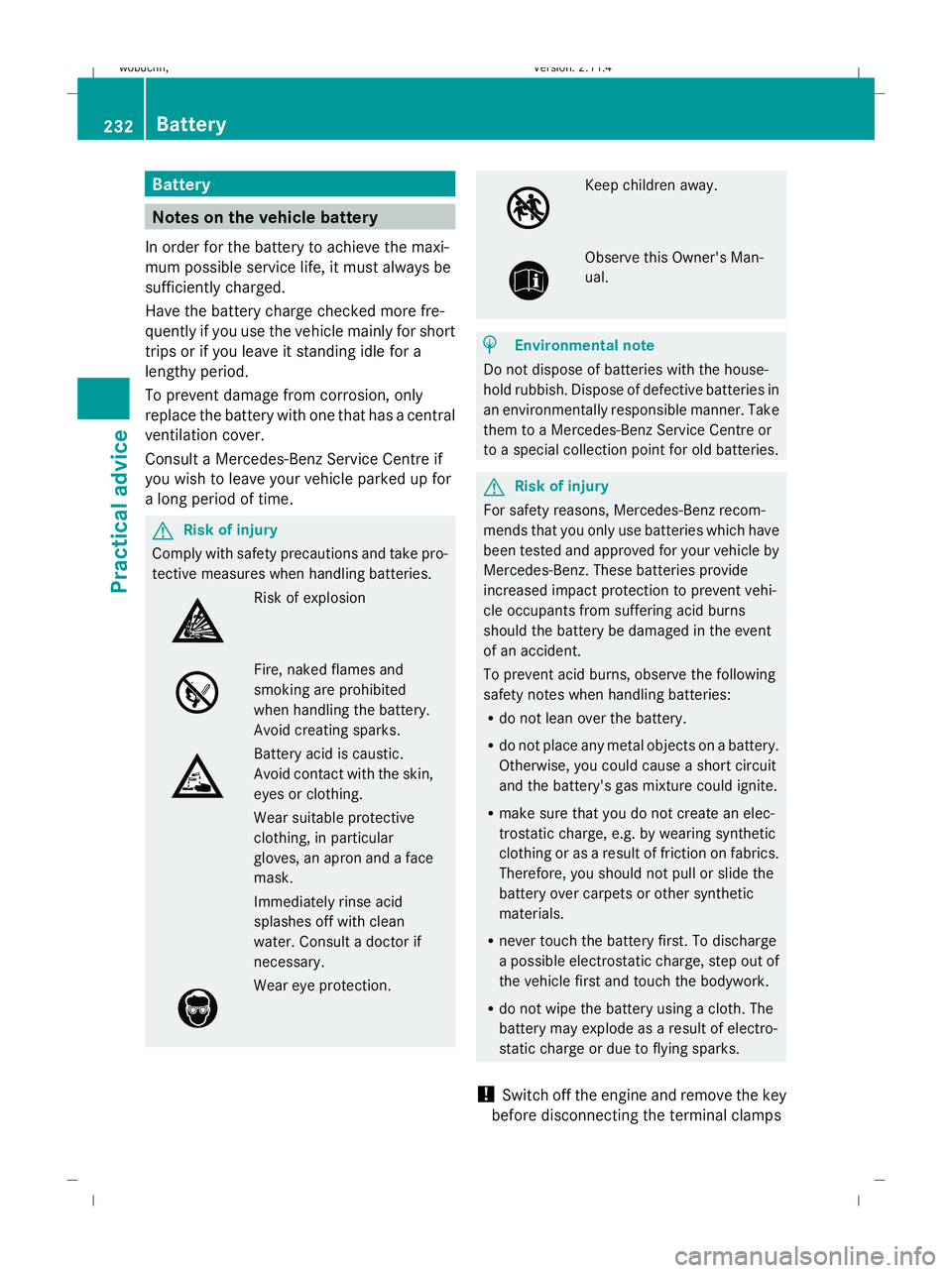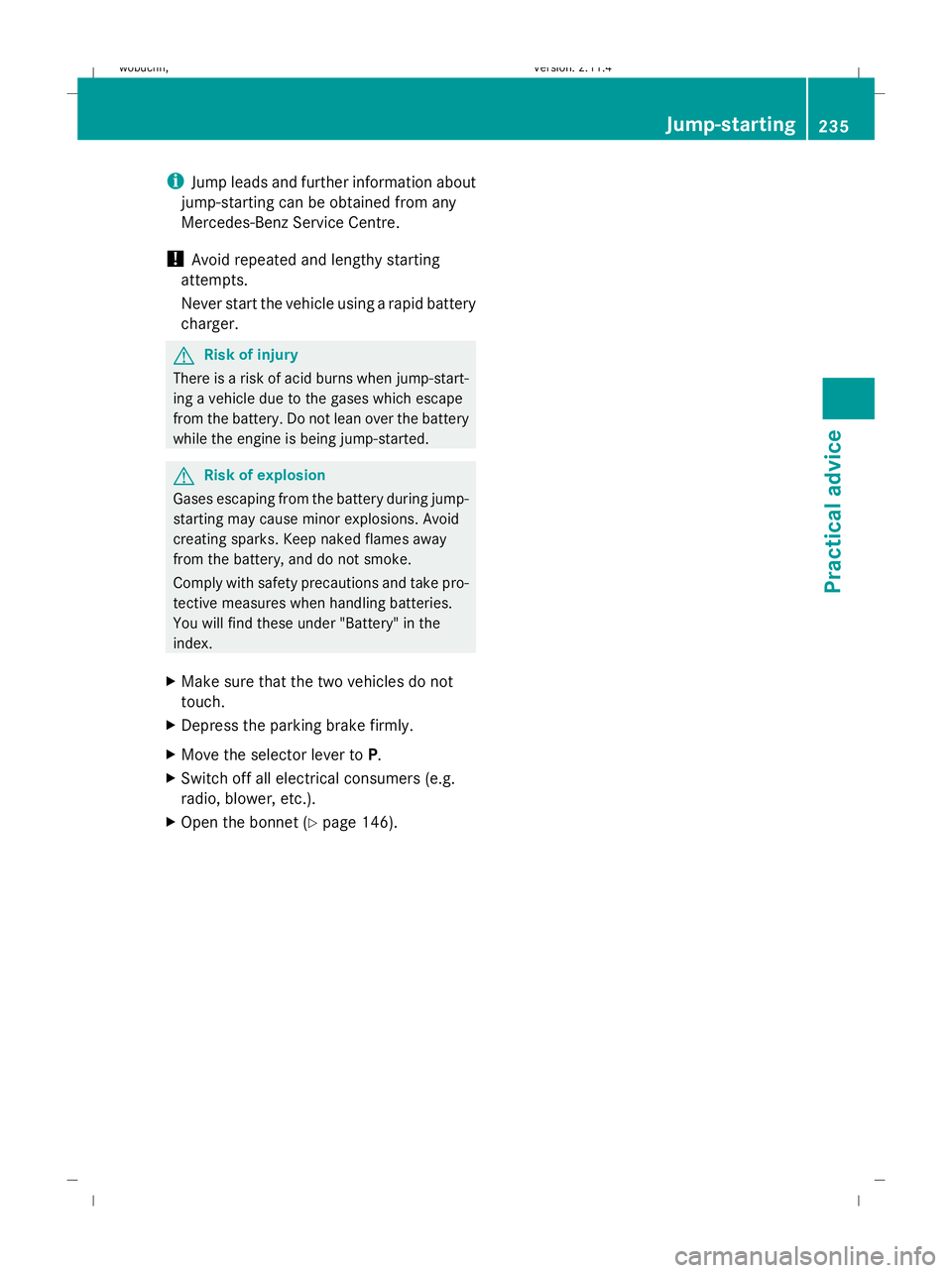Page 235 of 261

Battery
Notes on the vehicle battery
In order for the battery to achieve the maxi-
mum possible service life, it must always be
sufficiently charged.
Have the battery charge checked more fre-
quently if you use the vehicle mainly for short
trips or if you leave it standing idle for a
lengthy period.
To prevent damage from corrosion, only
replace the battery with one that has a central
ventilation cover.
Consult a Mercedes-Benz Service Centre if
you wish to leave your vehicle parked up for
a long period of time. G
Risk of injury
Comply with safety precautions and take pro-
tective measures when handling batteries. Risk of explosion
Fire, naked flames and
smoking are prohibited
when handling the battery.
Avoid creating sparks.
Battery acid is caustic.
Avoid contact with the skin,
eyes or clothing.
Wear suitable protective
clothing, in particular
gloves, an apron and a face
mask.
Immediately rinse acid
splashes off with clean
water. Consult a doctor if
necessary.
Wear eye protection. Keep children away.
Observe this Owner's Man-
ual.
H
Environmental note
Do not dispose of batteries with the house-
hold rubbish. Dispose of defective batteries in
an environmentally responsible manner. Take
them to a Mercedes-Benz Service Centre or
to a special collection point for old batteries. G
Risk of injury
For safety reasons, Mercedes-Benz recom-
mends that you only use batteries which have
been tested and approved for your vehicle by
Mercedes-Benz. These batteries provide
increased impact protection to prevent vehi-
cle occupants from suffering acid burns
should the battery be damaged in the event
of an accident.
To prevent acid burns, observe the following
safety notes when handling batteries:
R do not lean over the battery.
R do not place any metal objects on a battery.
Otherwise, you could cause a short circuit
and the battery's gas mixture could ignite.
R make sure that you do not create an elec-
trostatic charge, e.g. by wearing synthetic
clothing or as a result of friction on fabrics.
Therefore, you should not pull or slide the
battery over carpets or other synthetic
materials.
R never touch the battery first. To discharge
a possible electrostatic charge, step out of
the vehicle first and touch the bodywork.
R do not wipe the battery using a cloth. The
battery may explode as a result of electro-
static charge or due to flying sparks.
! Switch off the engine and remove the key
before disconnecting the terminal clamps 232 BatteryPractical advice
X204_AKB; 1; 5, en-GB
wobuchh,
Version: 2.11.4
2008-10-15T13:20:56+02:00 - Seite 232 Dateiname: 6515_0671_02_buchblock.pdf; preflight
Page 238 of 261

i
Jump leads and further information about
jump-starting can be obtained from any
Mercedes-Benz Service Centre.
! Avoid repeated and lengthy starting
attempts.
Never start the vehicle using a rapid battery
charger. G
Risk of injury
There is a risk of acid burns when jump-start-
ing a vehicle due to the gases which escape
from the battery. Do not lean over the battery
while the engine is being jump-started. G
Risk of explosion
Gases escaping from the battery during jump-
starting may cause minor explosions. Avoid
creating sparks. Keep naked flames away
from the battery, and do not smoke.
Comply with safety precautions and take pro-
tective measures when handling batteries.
You will find these under "Battery" in the
index.
X Make sure that the two vehicles do not
touch.
X Depress the parking brake firmly.
X Move the selector lever to P.
X Switch off all electrical consumers (e.g.
radio, blower, etc.).
X Open the bonnet (Y page 146). Jump-starting
235Practical advice
X204_AKB; 1; 5, en-GB
wobuchh, Version: 2.11.4 2008-10-15T13:20:56+02:00 - Seite 235 ZDateiname: 6515_0671_02_buchblock.pdf; preflight
Page 252 of 261

Windscreen washer system
The washer fluid reservoir holds approxi-
mately 6.0 litres.
The headlamp cleaning system* and wind-
screen washer system are both supplied from
the washer fluid reservoir.
Further information on windscreen washer
fluid and its mixing ratio (Y page 149).Vehicle data, GLK 280 4MATIC
Engine, GLK 280 4MATIC
Rated output
170 kW (231 bhp)
At engine speed
6000 rpm
Rated torque
300 Nm
At engine speed
2500 – 5000 rpm
Number of cylin-
ders
6
Displacement
2996 cm
3 Maximum engine
speed
6500 rpm
Performance, GLK 280 4MATIC
Maximum speed
210 km/h
Acceleration from
0 to 100 km/h
7.6 seconds
Vehicle dimensions, GLK 280 4MATIC
Vehicle length
(ECE)
4525 mm
Vehicle width
including exterior
mirrors
2016 mm Vehicle dimensions, GLK 280 4MATIC
Vehicle height
1683 – 1689 mm
Wheelbase
2755 mm
Vehicle weights, GLK 280 4MATIC
Unladen weight (in
accordance with
EU Directive)
34 1830 kg
Maximum roof
load
75 kg
You will find weight information specific to
the vehicle on the vehicle identification
plate (Y
page 244). Fuel consumption, GLK 280 4MATIC in
accordance with RL 80/1268/EEC
(Y
Y page 242) Urban
14.1 l/100 km
Extra-urban
8.3 – 8.4 l/100 km
Overall (NEDC)
10.4 – 10.5 l/
100 km CO
2emissions 244 – 246 g/km
Vehicle data, GLK 350 4MATIC
Engine, GLK 350 4MATIC
Rated output
200 kW (272 bhp)
At engine speed
6000 rpm
Rated torque
350 Nm
At engine speed
2400 – 5000 rpm
Number of cylin-
ders
6
34
The unladen weight includes the driver (68 kg), luggage (7 kg) and all fluids (fuel tank 90% full). Items of
optional equipment increase the unladen weight and reduce the maximum payload. Vehicle data, GLK 350 4MATIC
249Technical data
* optional
X204_AKB; 1; 5, en-GB
wobuchh,
Version: 2.11.4 2008-10-15T13:20:56+02:00 - Seite 249 ZDateiname: 6515_0671_02_buchblock.pdf; preflight
Page 253 of 261

Engine, GLK 350 4MATIC
Displacement
3498 cm
3 Maximum engine
speed
6300 rpm
Performance, GLK 350 4MATIC
Maximum speed
230 km/h
Acceleration from
0 to 100 km/h
6.7 seconds
Vehicle dimensions, GLK 350 4MATIC
Vehicle length
(ECE)
4525 mm
Vehicle width
including exterior
mirrors
2016 mm
Vehicle height
1683 – 1689 mm
Wheelbase
2755 mm
Vehicle weights, GLK 350 4MATIC
Unladen weight (in
accordance with
EU Directive)
35 1830 kg
Maximum roof
load
75 kg
You will find weight information specific to
the vehicle on the vehicle identification
plate (Y page 244). Fuel consumption, GLK 350 4MATIC in
accordance with RL 80/1268/EEC
(Y Y page 242) Urban
14.6 l/100 km
Extra-urban
8.4 – 8.5 l/100 km Fuel consumption, GLK 350 4MATIC in
accordance with RL 80/1268/EEC
(Y
Y page 242) Overall (NEDC)
10.6 – 10.8 l/
100 km CO
2emissions 249 – 251 g/km
Vehicle data, GLK 320 CDI 4MATIC
Engine, GLK 320 CDI 4MATIC
Rated output
165 kW (224 bhp)
At engine speed
3800 rpm
Rated torque
540 Nm
At engine speed
1600 – 2400 rpm
Number of cylin-
ders 6
Displacement
2987 cm
3 Maximum engine
speed
4200 rpm
Performance, GLK 320 CDI 4MATIC
Maximum speed
220 km/h
Acceleration from
0 to 100 km/h
7.5 seconds
Vehicle dimensions, GLK 320 CDI
4MATIC Vehicle length
(ECE) 4525 mm
Vehicle width
including exterior
mirrors 2016 mm
35
The unladen weight includes the driver (68 kg), luggage (7 kg) and all fluids (fuel tank 90% full). Items of
optional equipment increase the unladen weight and reduce the maximum payload. 250 Vehicle data, GLK 320 CDI 4MATICTechnical data
X204_AKB; 1; 5, en-GB
wobuchh,
Version: 2.11.4 2008-10-15T13:20:56+02:00 - Seite 250Dateiname: 6515_0671_02_buchblock.pdf; preflight